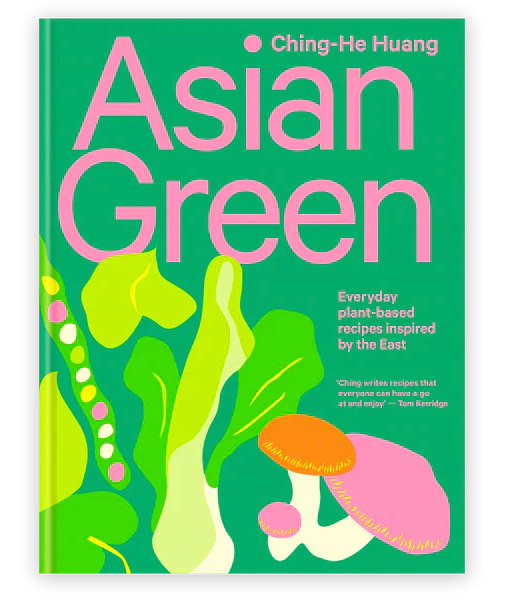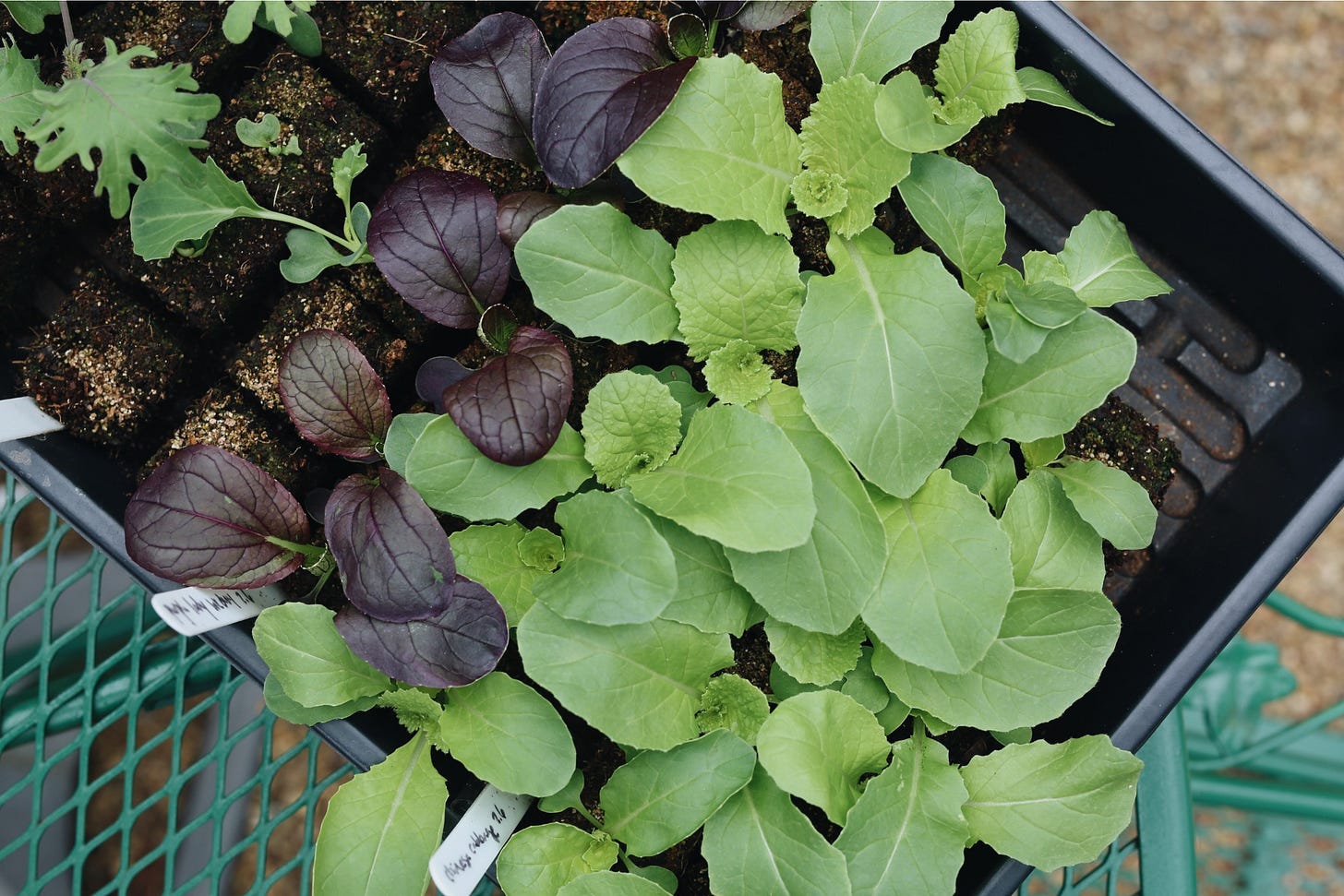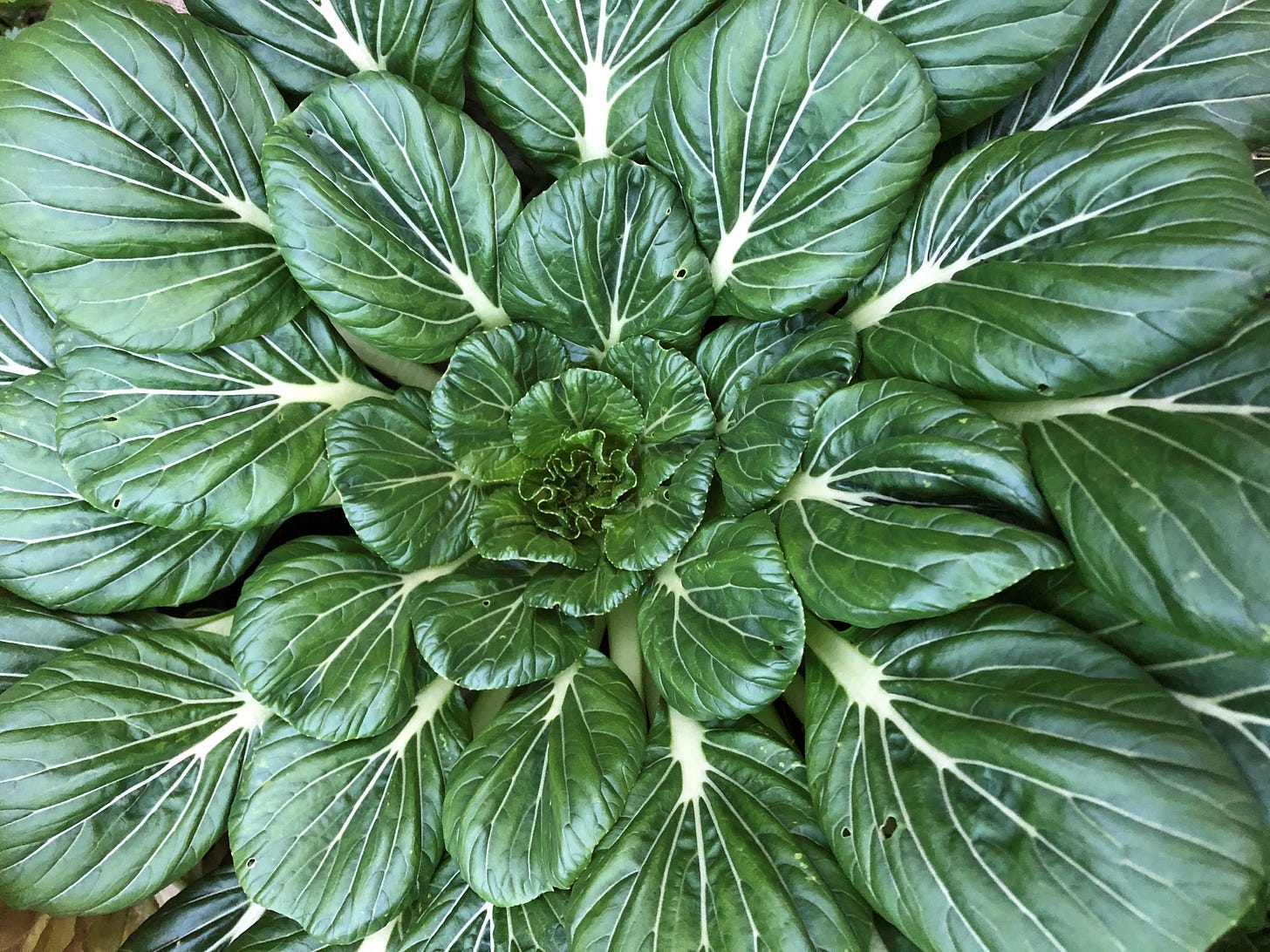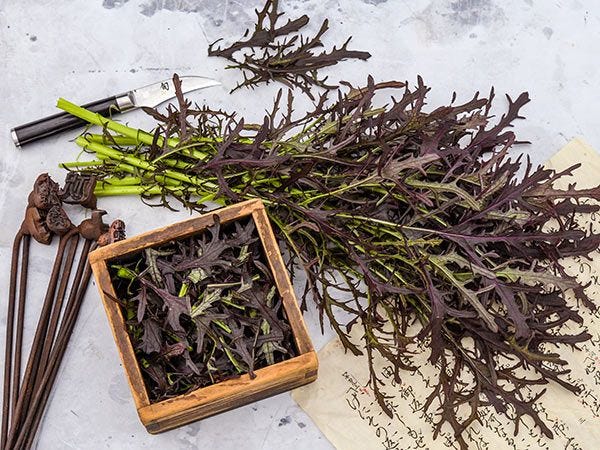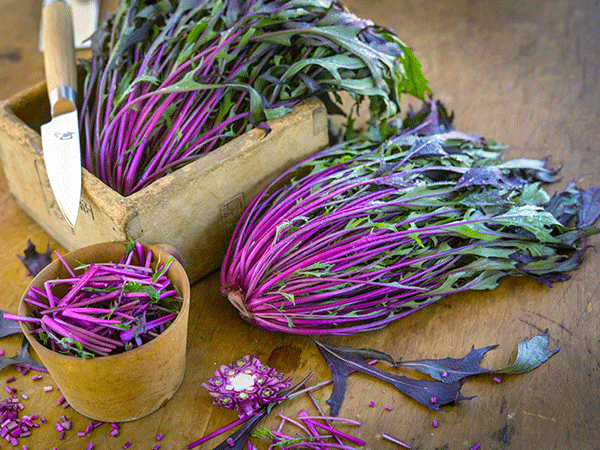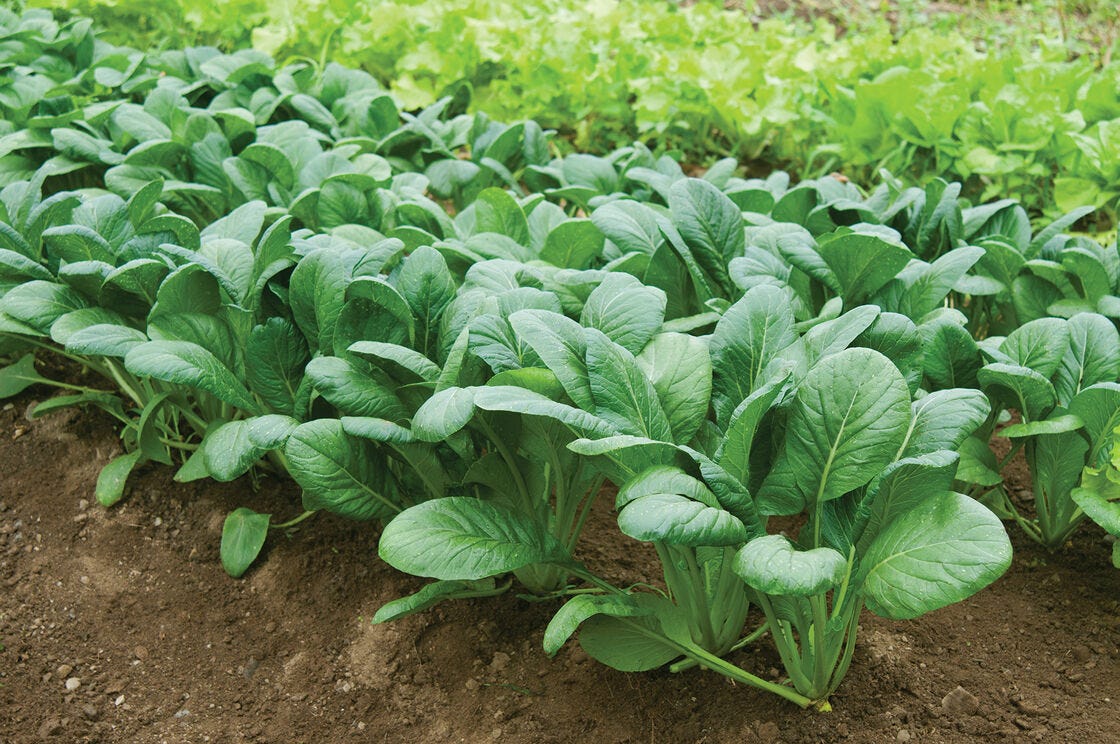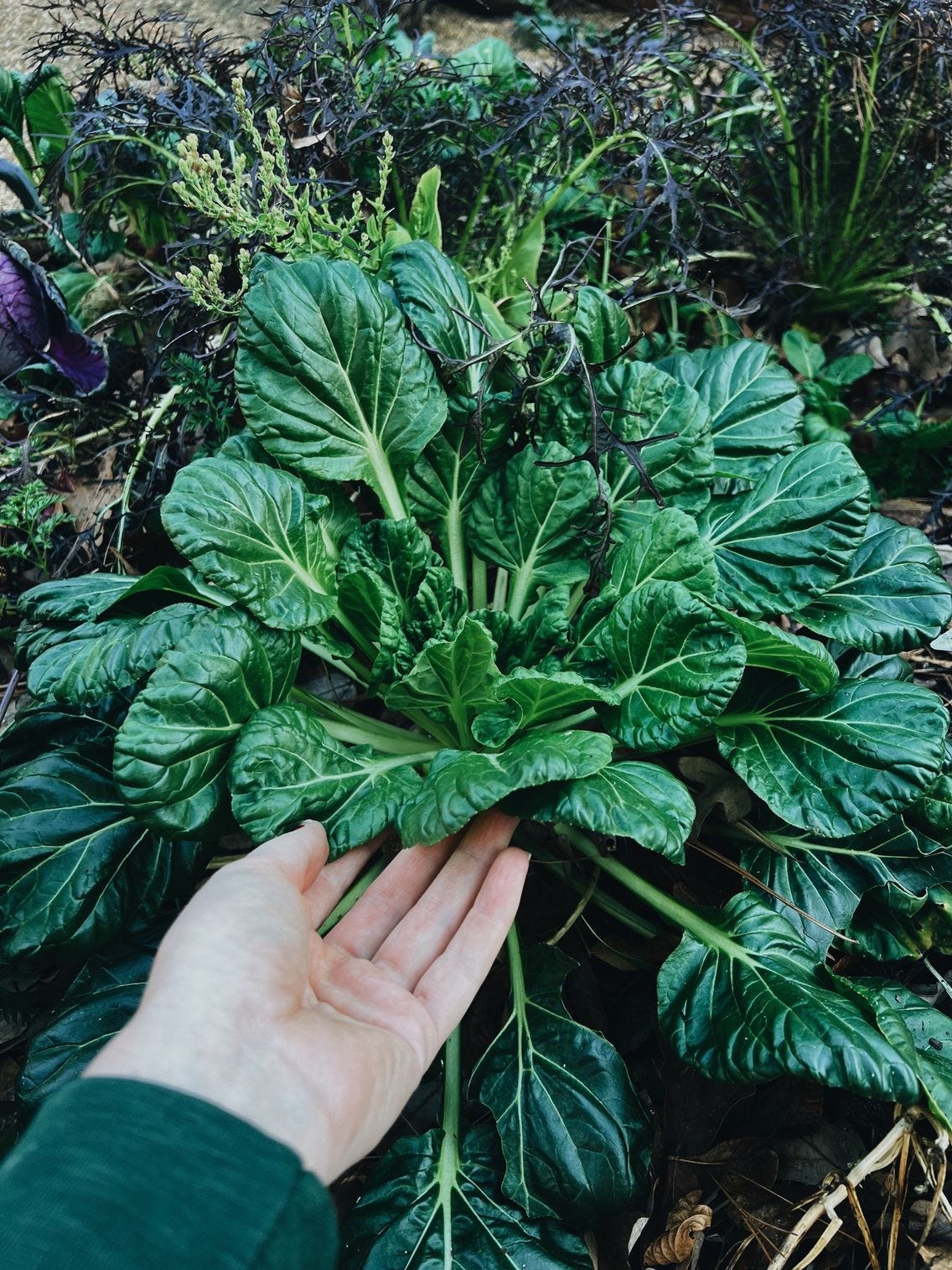in my defense of beans, i began to explore the legume family; home to peas, beans, peanuts and clover. there are what seems an infinite number of beans, and i didn’t begin to know the difference between any of them, which sent me down a hundred-hour rabbit hole of reading and researching the mysterious, magical, everyday bean.
asian greens are another often overlooked part of a different family: the brassicas. brassicas are sometimes referred to as the cole family, the cruciferous family, or mustard family. 🥦
this family is home to leafy plants with a nice “cronchy” stem: kale, broccoli, cauliflower, brussels, spinach, and arugula we are all acquainted with. asian greens, quite the opposite.
i have always ignored them in my grocery stores, in seed catalogs and nurseries. a specialty item, i thought. must be hard to grow, must be expensive, must be difficult. well, don’t we all laugh at our younger selves? (by the way, if you, my reader, have great experience with asian greens or cooking, please consider this email today’s entertainment and leave good advice in the comments; i will be indebted.)
after carelessly popping some tatsoi (what is it?? i don’t know!!) and mizuna (what is mizuna!! i don’t know!!) into my garden a few years ago and watching them thrive when much else suffered, and then grow through the rain and snow in in december, i got verrry curious. at this time, i was not really a salad person — but tatsoi was so sweet and crunchy i would eat them plain for a snack.
since then, i have taken up the opinion that these are the superior greens! i find them generally more flavorful, with better texture, and they’re all so attractive! their natural climate is in the tropics, though there are varieties from both colder and hotter regions, so they suit many zones well. i love that so many of them are frost hardy. ❄️
i would love to say they are measurably healthier because they have higher vitamin b, k, c, a, calcium, potassium, iron, specific carotenes, etc etc (all of which is true) but honestly, we have such an amateur understanding of the compounds found in plants and how they interact with our bodies, we still don’t have a way to measure their value. we just know that the more greens you eat the better - and these are some of the easiest, most delicious ones.
as for cooking - i have rudimentary skills with asian recipes, and will direct you to ching-he huang, a well known taiwan-born chinese chef from london, who wrote the delightful book ASIAN GREEN — and @madewithlau, randy lau and his dad who help people navigate asian markets and show what to do with different items, all on tiktok.
i have found that the mustards and tatsoi/chijimisai are great salad makers, and everything else shines when lightly sauteed or wilted in soups. light heat removes any bitter edge, but my experience with these greens is that they are typically sweeter than the greens i’ve grown up with. 🥬 (pad woon sen is my latest fav; look up a recipe and use whatever asian greens you like.)
lastly, i love them because most will grow in partial shade — a hard-to-come by gift! yes, they do enjoy great light and rich loamy soil, but i have snuck them in everywhere and they do not seem to mind. their seeds are viable for 3-5 years, so a few packets will allow you to experiment for several seasons.
most asian greens have bizarre superpowers, and you will learn more as you go. for example, a chinese napa cabbage can weigh up to 8-10 pounds in 60-80 days, and can be refrigerated for 8 weeks. this really puts romaine to shame.
SO WHAT ARE THEY? 🕵🏻
we think that brassica rapa originated in central asia, and likely was further domesticated in the mediterranean and india. the turnip was the first known vegetable in this species, and people continued to breed many versions of it for smaller roots and larger leaves — mostly resulting what we now know as asian greens. 🥬 because they are top heavy, they like lots of nitrogen and to be watered frequently, but not too deeply. 💦
drum-headed chinese cabbage - brassica rapa var. pekinensis
usually shorthanded as chinese cabbage, napa cabbage, or wong bok, these are very sweet on the inside and accumulate mass rapidly. serve them as the main dish, make kimchi, or add to stir fry. if you’re growing in spring, the early season varieties are ~50 days: nerva, summer top, blues, and kasumi. if you’re growing for fall, main season varieties take 65-80 days: china pride, orange queen, michihli, jade pagoda, and monument. i am growing golden beauty (55 days) this spring.
bok choy / loose-headed chinese cabbage - brassica rapa var. chinensis
called bok choy or pak choi, i think of these as a loose leaf lettuce but with heft. they’re more heat tolerant than drumheads and they grow fast: ~40 days. originating in southern china, they can handle more humidity and warmth. there are SO many varieties of these and they come large, small, and mini. i’m growing the mid-size purple lady and it’s beautiful. i just drizzle olive oil and saute or lightly braise. they’re the best side item. / SPRING + FALL
tatsoi / rosette pak choi - brassica rapa var. rosularis
my sweet darling tatsoi! my salad queen! i compare it to a buttercrunch / bibb lettuce. a bok/pak choi that grows in a rosette shape, also called tah tsai or spinach mustard. this is one of the most cold tolerant, surviving up to 15-20° and even being snowed upon. it is SO sweet and catches everyone’s eye. perfect for beginner gardeners. / SPRING + FALL + WINTER
mizuna - brassica rapa var. japonica
mizuna strikes me as the hardiest of all asian greens. it thrives in both heat and cold, and likely is assisted by it’s unique leaf shape — almost razor-like. it looks gorgeous in the garden and adds so much to a salad. it’s got a gentle kick to it. they grow so quickly (30-40 days) are cut-and-come-again; you only need a couple for the whole season. they will take up an entire square foot but you could pack more closely if you’re harvesting frequently. / SPRING + SUMMER + FALL + WINTER
chinese mustard - brassica juncea
spiiiiice in the house. osaka purple and giant red are two wonderful varieties and are like a full leaf iteration of mizuna. even though they originated in the mountains, they can stand the heat. peppery, mustardy, yum. i will say: when it comes to asian greens, the more flavor and/or color = the more nutrients. you can grow them densely and pick small leaves for salads, or grow more spaciously for heartier space on the plate. / SPRING + SUMMER + FALL
komatsuna - brassica rapa var. perviridis
sort of like a mustard but more fresh and sweet. the little yellow flowers are edible and you know i love to eat a flower. 🌼 komatsuna has a rich heritage in japan, and is offered to the gods on new years eve, and the people on new years day. it is extremely sensitive to bolt and will do best in the fall. / FALL
chijimisai
a new cross between tatsoi and komatsuna, with 4x more vitamin a than carrots! happy in partial shade, can grow nearly year round in moderate climates, but can also take up to 80 degrees! it’s more velvety than tatsoi, so if you’re looking for a spinach replacement, this is your guy. / SPRING + SUMMER + FALL + WINTER
winter choy
also called, ‘golden flower in the snow,’ this is your WINTER OPTION. it will handle snow and terribly low temps, and seems to be a miracle plant. i haven’t grown it yet but i can’t wait. if you’ve been wanting to experiment with foodscaping, this is a lovely choice. / FALL + WINTER
chinese celery - apium graveolens var. secalinum
ok we are family jumping!! chinese celery is in the parsley family, and is different than western celery. the stalks are thinner, the flavor is more potent, and the leaves can and should be cooked with. for western celery, we focus on the base stalks but for chinese celery, focus on the upper leafy stalks. i’ve given chinese pink celery a hard time in earlier writings, but i was using it incorrectly - and also should have harvested it by early summer before 90 hits. eat ‘em young! / SPRING + FALL
tong ho / chop suey green - asteraceae glebionis coronaria
these little seedlings are under the grow lights right now. 🌼 they are a chrysanthemum (my birth flower, for you november babies). grow them in full sun for mild climates and with a little shade protection in hot summer climates. yet another plant whose leaves and flowers can be eaten. like everything else, most delicious when harvested young and tender. / SPRING + SUMMER + FALL
alright cult kids - there are more asian greens to discover but i do hope this has given you the confidence if not the curiosity to add some to your yards or containers this year. eat your greens, live long, and remember: you are in your body, that is where you will find yourself.
lauren xo





